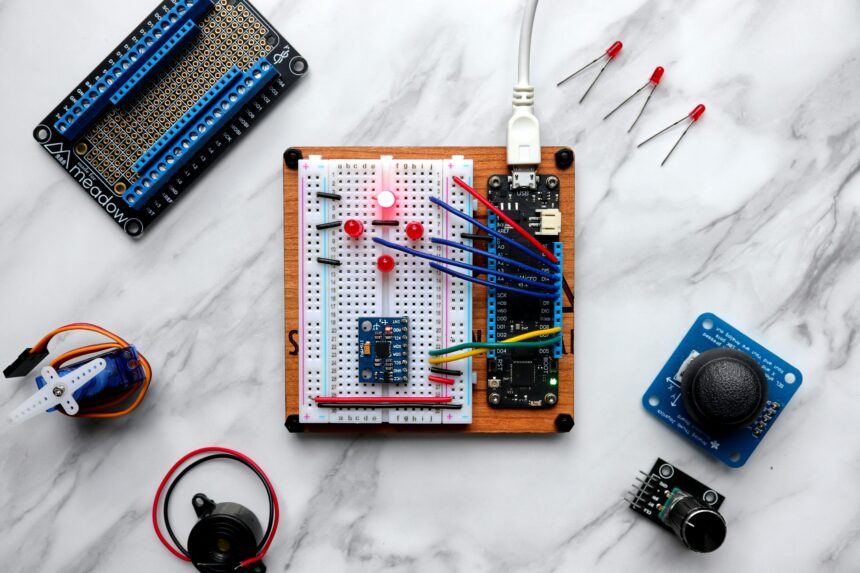The Convergence Point: AI Meets the Edge
The story of Artificial Intelligence has historically been one of massive compute power—training billion-parameter models in distant, power-hungry cloud data centers. The story of the Internet of Things (IoT) has been one of massive data generation—sensors, cameras, and devices proliferating across every industry. In 2025, these two trends have converged at the “Edge,” creating the most disruptive shift in enterprise architecture since the invention of the public cloud.
- The Convergence Point: AI Meets the Edge
- The Pillars of Edge AI Architecture
- 1. Model Optimization: Making Giants Run on Batteries
- 2. Specialized Edge Hardware: The NPU Revolution
- 3. Deployment and Management: Hybrid Cloud Control
- Edge AI Use Cases: Transforming Industries
- 🏭 Industrial IoT (IIoT) and Predictive Maintenance
- ⚕️ Healthcare and Remote Monitoring
- 🚗 Autonomous Vehicles and Vision Systems
- The Future Frontier: Federated Learning
- Conclusion: The Strategic Imperative
Edge AI is the practice of running machine learning inference (and sometimes training) directly on or near the device that is collecting the data. This paradigm shift addresses the fundamental limitations of cloud-centric IoT: latency, bandwidth, and privacy.
- Latency: Sending video from a self-driving car sensor to the cloud for analysis, waiting for a decision, and sending the instruction back takes time—time a car does not have to avoid a collision.
- Bandwidth: The IoT Analytics 2025 report projects over 21 billion connected IoT devices are generating 80 zettabytes of data annually. Shipping all that raw video and sensor data to the cloud is financially and technically unsustainable.
- Privacy: Regulations like GDPR and HIPAA strictly limit the transmission of sensitive data, making local, on-device processing a legal and ethical necessity for sectors like healthcare and surveillance.
This technical necessity has translated into a massive market opportunity. Precedence Research estimates the global Edge AI market will reach $25.65 billion in 2025, underlining that this is no longer a niche technology but the core architectural foundation for modern digital infrastructure.
The Pillars of Edge AI Architecture
To successfully deploy sophisticated AI models on devices with tiny processors and limited battery life, the enterprise must master three technical pillars: Model Optimization, Specialized Hardware, and Deployment Strategy.
1. Model Optimization: Making Giants Run on Batteries
AI models, especially those used for computer vision (Convolutional Neural Networks or CNNs) or advanced audio processing, are notoriously large. Running a model with millions of parameters on an IoT camera’s ARM chip requires aggressive optimization techniques.
A. Quantization
This is the most crucial technique. Traditional AI models store their weights and activations using 32-bit floating-point numbers. Quantization reduces this precision, typically down to 8-bit integers (INT8).
- The Benefit: Reducing the size of the numerical representation leads to a $75\%$ reduction in model size and often a 4x increase in inference speed because integer arithmetic is simpler and faster for low-power chipsets. The trade-off is a minimal, often negligible, drop in accuracy.
B. Pruning and Knowledge Distillation
- Pruning: Eliminates redundant or “unimportant” weights and connections in the neural network, effectively slimming down the model without losing core functionality.
- Knowledge Distillation: A small, lightweight “student” model is trained to mimic the output of a large, complex “teacher” model (which was trained in the cloud). The student model is small enough to run on the device while maintaining high performance.
2. Specialized Edge Hardware: The NPU Revolution
Traditional Central Processing Units (CPUs) are generalists. They are excellent for running operating systems and general applications, but they perform poor parallel processing of matrix multiplications—the core operation of a neural network.
The Edge AI revolution is being driven by Specialized Hardware Accelerators:
- Neural Processing Units (NPUs): These silicon chips are purpose-built to execute AI inference at extremely high speeds while consuming minimal power. Companies like Qualcomm, Intel, and Apple now embed NPUs directly into their chipsets, making on-device AI a default feature.
- Microcontroller Units (MCUs): For the most constrained devices (like smart meters or tiny sensors), new IoT MCUs are now embedding basic AI capabilities (e.g., keyword spotting for voice activation) directly into the silicon logic, consuming only milliwatts of power.
- FPGAs (Field-Programmable Gate Arrays): Used primarily in industrial edge gateways, FPGAs offer reconfigurability, allowing a company to tune the hardware logic precisely for a specific AI model or task, maximizing efficiency.
3. Deployment and Management: Hybrid Cloud Control
The Edge is distributed, meaning managing and updating thousands of scattered devices is the most significant operational challenge. A security camera running a faulty AI model must be patched instantly.
Modern Edge AI deployments rely on a Hybrid Architecture managed by cloud tools (AWS IoT Greengrass, Azure IoT Edge, or specialized SaaS platforms):
- Containerization: AI applications are packaged in small, secure containers (e.g., Docker or lightweight equivalents). This standardizes deployment, allowing the exact same model to run on various hardware types (a server, a gateway, or a camera).
- Over-The-Air (OTA) Updates: The cloud platform manages the fleet, pushing model updates or security patches to edge devices without requiring physical access.
- Shadow Devices (Digital Twins): In the cloud, a “Digital Twin” of the edge device is maintained. Before deploying a new AI model to the production fleet, it is tested on the digital twin to predict its performance and power consumption, significantly reducing failure rates.
Edge AI Use Cases: Transforming Industries
The real-time decision-making capability of Edge AI is fundamentally changing industries where latency is a cost driver or a safety risk.
🏭 Industrial IoT (IIoT) and Predictive Maintenance
In manufacturing, a delayed decision can mean millions in downtime.
- Application: AI models running on sensors attached to assembly line robotics monitor vibration and thermal signatures.
- The Edge Benefit: Instead of sending gigabytes of vibration data to the cloud, the Edge AI analyzes the patterns locally. If it detects a signature matching an impending bearing failure, it triggers a maintenance alert within milliseconds. This shifts maintenance from reactive or scheduled to truly predictive, boosting operational efficiency by up to 40% in some verticals.
⚕️ Healthcare and Remote Monitoring
Patient data is the most sensitive data, making Edge AI crucial for compliance.
- Application: Wearable devices and hospital sensors (ECG, EKG) use AI to monitor vital signs.
- The Edge Benefit: The AI detects cardiac arrhythmias or blood oxygen drops on the device itself. Only a critical alert is sent to the cloud, protecting the raw, sensitive patient data from unnecessary transmission and reducing the risk of a HIPAA violation.
🚗 Autonomous Vehicles and Vision Systems
Autonomous driving is the ultimate low-latency application.
- Application: Cameras and LiDAR sensors use AI models to identify pedestrians, traffic signs, and other vehicles.
- The Edge Benefit: These decisions (collision avoidance) must occur in less than 10 milliseconds. The entire perception pipeline runs on specialized NPUs within the car’s compute stack, ensuring instantaneous reaction times independent of a network connection.
The Future Frontier: Federated Learning
As the Edge AI market matures, the next competitive frontier is model training. How can we improve the AI model running on 10,000 devices without ever viewing the sensitive data on those devices?
Federated Learning is the answer. It is a machine learning technique where the model is trained collaboratively by numerous decentralized edge devices, circumventing the need to centralize the data.
- Local Training: The central cloud model is pushed to 10,000 devices. Each device (e.g., a security camera) trains the model locally using its own specific data (e.g., local light conditions, local faces).
- Gradient Sharing: Instead of sending the raw data back, the device sends only the model update (the mathematical “weights” or “gradients”) back to the central server.
- Aggregation: The central server averages all the updates from the 10,000 devices to create a new, globally improved model.
This innovative approach allows a single company to achieve the scale of centralized training while maintaining the data privacy and sovereignty required in a highly regulated global environment, solidifying Edge AI’s role as the foundation for future intelligent systems.
Conclusion: The Strategic Imperative
The exponential growth of IoT devices makes Edge AI a foundational strategic imperative for CTOs and product managers in 2025. With Gartner predicting over 50% of enterprise data will be processed outside traditional data centers, organizations that fail to adopt this architecture will be burdened by high cloud egress fees, unacceptable latency in critical systems, and increased regulatory risk.
The competitive advantage no longer lies in what data you collect, but how fast and where you process the critical $1\%$ of that data to drive real-time decisions. Investing in the optimization tools, NPU-accelerated hardware, and hybrid deployment frameworks for Edge AI is key to unlocking the true, cost-effective, and safe potential of the Internet of Things.
Source List
- IoT Analytics:State of IoT 2025: Number of Connected IoT Devices Growing to 21.1 Billion (2025)
- Gartner:Forecast: Over 50% of Enterprise Data Processed Outside Traditional Data Centers by 2025 (2025)
- Precedence Research:Edge AI Market Size to Attain $143.06 Billion by 2034 (2025)
- McKinsey:Technology Trends Outlook 2025: Scaling and Specialization (2025)
- Grand View Research:Edge Computing Market Size, Share, & Trends Analysis Report (2025)

